Review of the best according to the editorial board. On the selection criteria. This material is subjective and does not constitute advertising and does not serve as a purchase guide. Before buying, you need to consult with a specialist.
Nature has generously endowed the birds with beauty. Individual members of the feathered family are so attractive that their feathers were used as decorations. And, for example, English scientists for a long time could not believe in the existence of birds of paradise – they are so amazingly beautiful. Even in spite of the fact that seafarers generously supplied the British scientific community with stuffed birds.
We have collected 12 of the most beautiful birds in the world, so you can also enjoy the beauty of these amazing creatures.
Rating of the most beautiful birds in the world
| Nomination | a place | Bird | rating |
| Rating of the most beautiful birds in the world | 1 | Peacocks | 5.0 |
| 2 | Quetzal (quetzal) | 4.9 | |
| 3 | Birds of paradise | 4.8 | |
| 4 | Blue jay | 4.7 | |
| 5 | Mandarin duck | 4.6 | |
| 6 | Flamingo | 4.5 | |
| 7 | Long-tailed turaco | 4.4 | |
| 8 | Crowned crane | 4.3 | |
| 9 | Hyacinth macaw | 4.2 | |
| 10 | Astrapia | 4.1 | |
| 11 | Hoopoe | 4.0 | |
| 12 | Maned pigeon | 3.9 |
Peacocks
Rating: 5.0
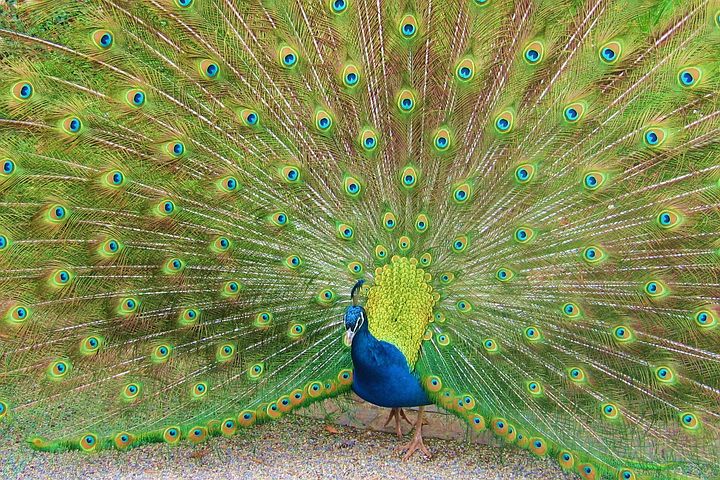
Of course, it is worth starting with a bird, which was kept for beauty by the most regal and privileged persons – Indian shahs, Greek and Roman emperors, Chinese and Japanese nobles – with a peacock. This representative of the pheasant family has been accompanying mankind for 3000 years, delighting with its beauty.
First of all, the peacock is known, of course, for its tail. During mating dances and just to demonstrate its superiority, the bird reveals huge blue-green feathers with 'eyes'. The tail can be up to 160 centimeters long – many times longer than the peacock itself! For the birds themselves, this 'decoration' has a purely utilitarian character, though. With the help of a bright tail, male peacocks attract females, arranging full-fledged mating rituals with dances, and also scare away less fortunate 'boyfriends'.
However, you can admire not only the tail. Peacocks, in principle, are very brightly colored – sapphire neck and chest, variegated black and white wings, a characteristic crest on a contrastingly colored head.
Only male peacocks are so brightly colored. Females are much less bright, gray-brown, without an impressive upper tail. With males, they are only related to the characteristic crest, however, also brown.
Peacocks are partially domesticated birds. Therefore, they can be found in almost any zoo. And if you have a large enough enclosure (and a considerable budget, of course), you can even keep peacocks at home.
Quetzal (quetzal)
Rating: 4.9
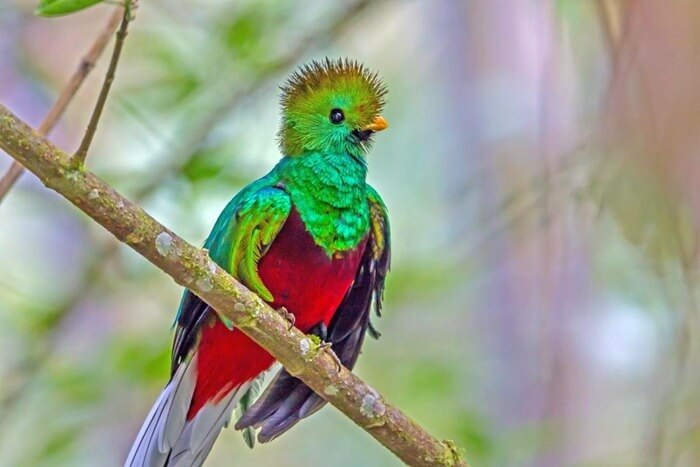
Quetzal, aka quetzal, is an amazing bird, not only in terms of beauty. She is also a real symbol of freedom! In captivity, quesal cannot be found – the bird needs a huge space to live, and once in the aviary, it begins to wither and eventually dies.
Kwezal is a truly iconic bird. She was revered by the ancient Mayans, considering it the embodiment of the god of air. And in modern Guatemala, the quetzal is a state symbol and a national symbol of freedom.
Kwezali, like other inhabitants of the jungle, is very bright and colorful. Bright red belly and chest, emerald green wings with black flight feathers, funny crest on the head. But what is most impressive is the tail. It is huge, up to 35 centimeters long, and consists of two soft green feathers that develop during flight.
Kwezali are rare birds listed in the Red Book. During the conquest of South America by the conquistadors, these navigators mercilessly destroyed the 'symbols of freedom'. And even though the quesal meat was not tasty, the long tail feathers were too attractive, and European nobles tried to decorate their costumes with them.
Today, quezals are under the protection of several Guatemalan and international organizations. As mentioned above, this bird does not live in captivity and does not breed. Therefore, to admire its beauty, it is worth going to the jungles of South America.
Birds of paradise
Rating: 4.8
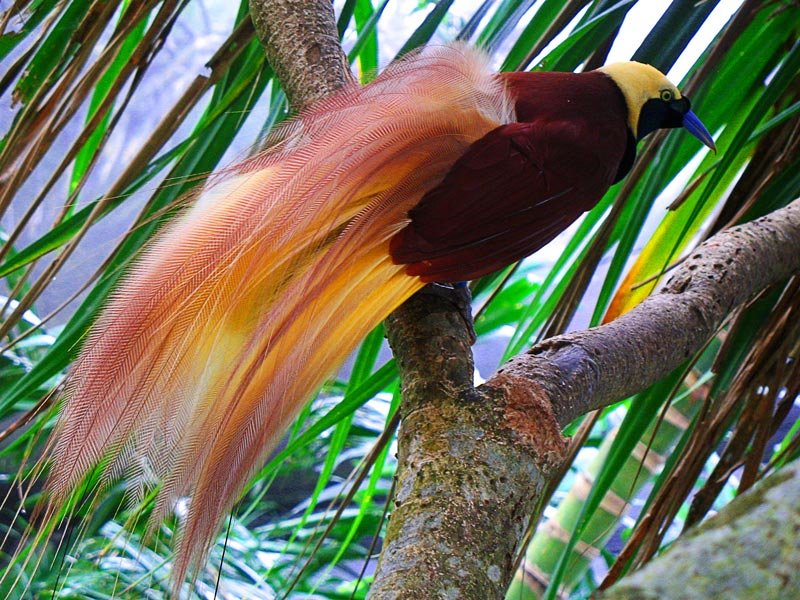
It is very difficult to choose one species of bird of paradise to include in the list. Because each of them is insanely beautiful, attractive and interesting. In total, the family of birds of paradise includes 45 species that live mainly in New Guinea.
The birds of paradise are characterized by bright, multicolored plumage. Even if at first glance it is inconspicuous, a riot of colors can be demonstrated during the mating dance. For example, the wonderful bird of paradise (Lophorina superba), when calm, looks like an ordinary rook due to its shiny black plumage. But as soon as the mating dance begins, the bird opens its shining blue chest. The special plumage structure and special muscles make this bright blue spot literally glowing and 'blinking'.
Another interesting species is the blue-headed magnificent bird of paradise. Its plumage is painted literally in all colors of the rainbow. The back is scarlet, the chest is green, the wings are brown, the neck is yellow, the head and legs are blue. But tail feathers are of particular interest – they are long and curved, curling into a spiral.
The astrapia of Princess Stephanie can also boast of a luxurious long tail. The tail feathers of this bird are 2-3 times longer than the body itself and are painted in a shiny, shiny black color. In addition, Princess Stephanie's astrapia boasts an interesting bright blue 'collar' made of feathers.
Many birds of paradise have suffered at the hands of poachers and due to deforestation, therefore they are included in the Red Book and are under international protection. As a result, they are almost never found in zoos.
Blue jay
Rating: 4.7
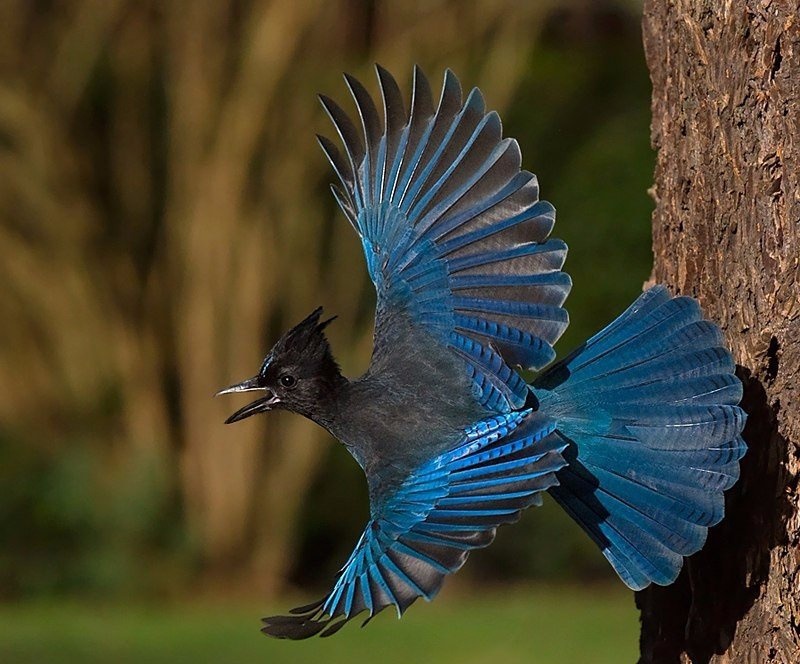
The blue jay is the very 'ultramarine color bird of luck', sung in songs and folk expressions. And for good reason. The blue jay, as the name implies, is colored in all shades of blue, from heavenly to sapphire, almost black, and therefore is incredibly beautiful.
It is very difficult to find plumage on the body of a blue jay that is different in color from blue. Only the wings have snow-white stripes. And the 'rim' around the neck, which at first glance seems black, is in fact a deep sapphire color. And even the beak is deep blue – such as is called the royal one.
Blue jay is a rather large bird. In size, it can reach up to 30 centimeters in length, and the wingspan is up to 42 centimeters. But at the same time, like many other corvids, it is light – even the largest specimens weigh no more than 100 grams. This unusual combination of size and weight is due to the fact that blue jays spend a lot of time in the air. She often migrates across the range, moving to the southern territories with the onset of cold weather.
The blue jay is found in North America. Therefore, in 'our latitudes' this bird can only be found in zoos. True, we have a common jay, on whose body there is a 'sign of kinship' with the 'American sister' – bright blue stripes on the wings.
Mandarin duck
Rating: 4.6
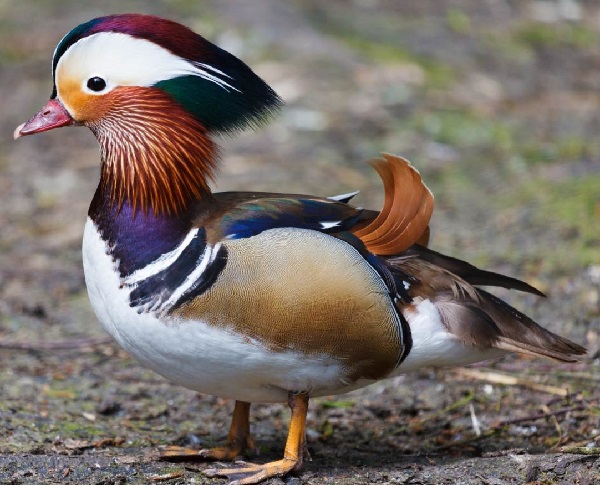
Mandarin duck is rightfully one of the most beautiful ducks. Painted brightly, motley, in a variety of colors, it attracts the attention of fans of unusual birds. An interesting feature of the duck is also the unusual form of feathering on the wings – at the ends it bends upwards, creating something like a 'cloak' or 'collar'.
Of course, the males of mandarins are primarily motley and brightly colored. Moreover, they take such an impressive appearance mainly in the spring-summer period, when it is required to seduce the female. By autumn, the tangerine turns brown-brown. But these ducks create couples for life and raise chicks together. That is why, in Chinese culture, they are a symbol of loyalty and eternal love.
Mandarin ducklings are ubiquitous. You can find them even in Eurasia – for this, however, you have to find a suitable mountain river. However, the mandarin duck has long been successfully domesticated and bred in zoos and parks.
Flamingo
Rating: 4.5
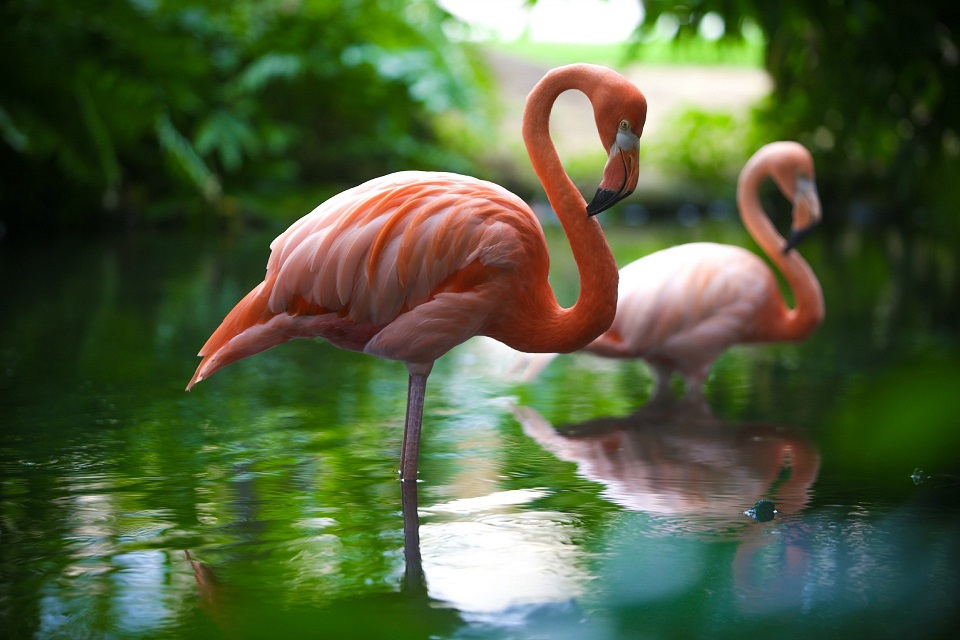
Flamingos are known primarily for their bright pink plumage and tendency to gather in huge flocks. Their flight or feeding is an exciting sight. Flocks of flamingos occupy the entire coastline of a lake, and in flight they darken the sky to the horizon, painting the landscape in bright pink.
However, not all flamingos are pink. Among them, there are white individuals, and colored in coral, and bright red. Interestingly, the color of the plumage of flamingos depends a lot on the diet. The pink hue is given to them by pigments from small crustaceans, which these birds eat. Therefore, when kept in a zoo, a variety of coloring products are added to the water, where flamingos live, including grated carrots and sweet pepper puree.
Flamingos can live even in conditions in which other birds die. Their colonies are found near salty and alkaline lakes, in cold and heat. The thick skin on the legs of flamingos helps them protect themselves from the aggressive action of solutions.
One of the most interesting features of flamingos is that they feed their chick with real bird milk. True, it has little in common with the nutrient fluids in mammals (and even more so with the candies of the same name). Bird's milk is secreted by special glands and consists of a quarter of the parent's blood.
Flamingos are ubiquitous, but most of them are found in Africa, Asia and South America. You can even find them in Azerbaijan! In addition, flamingos are frequent inhabitants of zoos.
Long-tailed turaco
Rating: 4.4
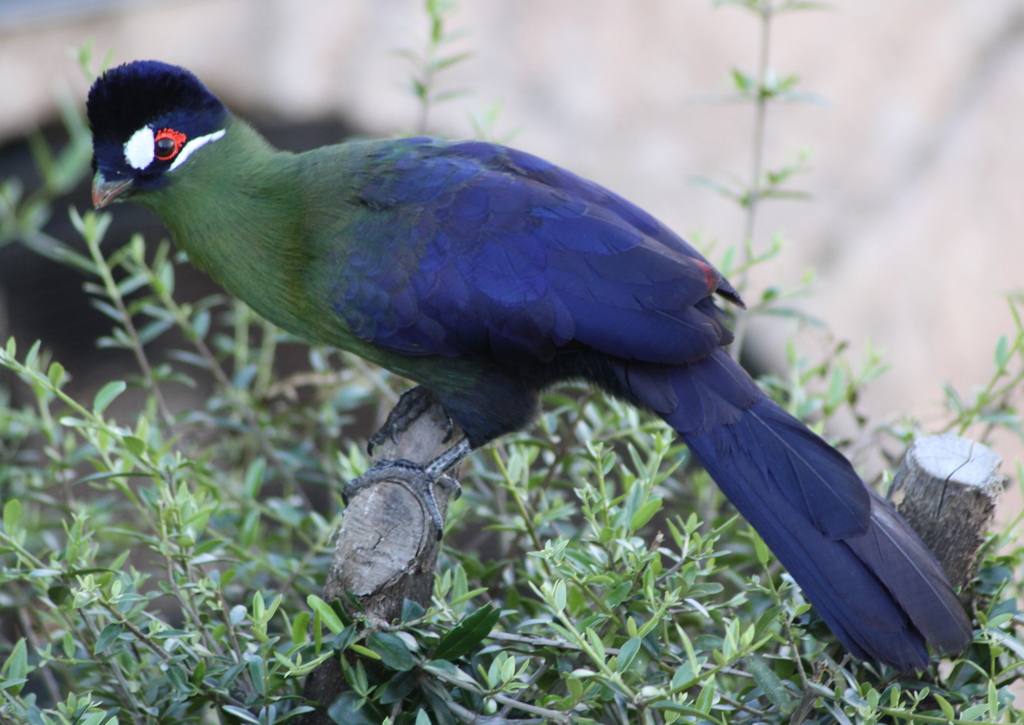
The Long-tailed Turaco, also known as Livingston's banana-eater, is a small, little-known bird that lives in the forests of southern Africa. But it looks impressive, so it definitely deserves to be included in the rating. The bird is painted in all possible shades of green – from light green on the head to emerald on the wings. The long tail is completely black.
In addition, the bird has several bright color accents. The eyes are adorned with white and black arrows and a red rim. The beak is carrot orange. The crest on the head is green, but the feathers end in white inserts. The general appearance is very elegant, as if a bird turned to a stylist and got professional makeup done there.
As the name suggests, Livingstone's banana food is based on various fruits and vegetables. But the bird has a special passion for bananas, being practically a pest – flocks of long-tailed turaco ravage plantations. However, in the 'off-season', a banana eater can eat insects.
Long-tailed turaco is practically not found in zoos – the bird needs a warm climate and does not reproduce well in captivity. Therefore, to admire it, you have to go to Africa.
Crowned crane
Rating: 4.3
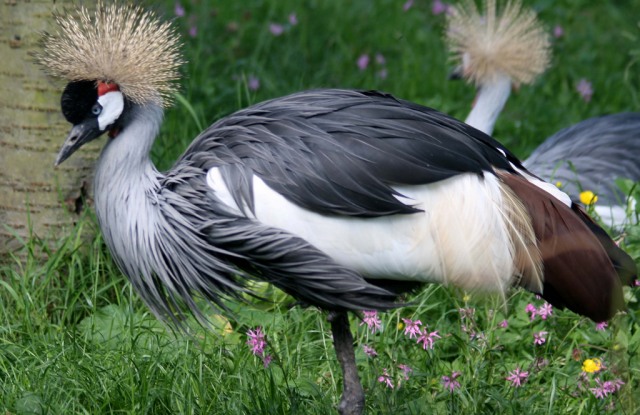
The crowned crane is a large and impressively beautiful bird. Her body is painted mostly black with infrequent white accents. However, on the head of this crane is a large crest, painted in gold, as well as accent red spots. Thanks to this crown-like crest, the bird got its name.
Crowned cranes are lovers of warm climates and open water areas. Therefore, they can be found in the north and east of Africa, as well as in some Asian countries. Mostly birds settle along lakes and swamps, but recently they have chosen rice plantations. Unlike other species of cranes, crowned cranes thrive on trees and often build nests on acacias.
Crowned cranes are not afraid of humans. They often settle near dwellings, sometimes – like storks – arranging nests directly on the roofs.
Crowned cranes are vulnerable bird species and are included in the International Red Book. They are often protected in zoos, nature reserves and wildlife sanctuaries. However, birds reproduce normally in captivity and do not experience stress from being close to humans. Therefore, they can often be admired in zoos.
Hyacinth macaw
Rating: 4.2
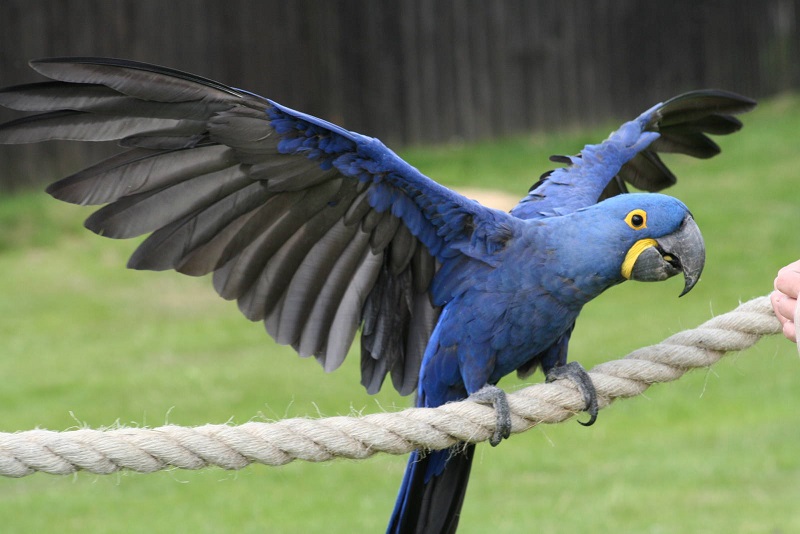
The hyacinth macaw is the largest of the parrots. This bird can grow up to a meter in length and weigh almost one and a half kilograms! True, the wings of the hyacinth macaw are short – even in the largest specimens, their span is about 70-75 centimeters. Therefore, the parrot flies slowly, heavily, noisy and close.
However, the hyacinth macaw does not need to fly far. The bird is omnivorous and has a powerful beak, thanks to which it easily gnaws fruits, nuts, berries and shells of mollusks. Like many other parrots of the macaw family, the hyacinth lives in flocks and is an agricultural pest – since after a raid on a fruit plantation, people have practically nothing left.
The hyacinth macaw is almost entirely cobalt blue, only on the wings there are a few black feathers. In addition, the bird's head has yellow stripes around its beak and eyes. They are not covered with feathers, the yellow color is the parrot's skin itself.
Due to its bright blue color and large size, as well as due to aggressive and pesting behavior, the hyacinth macaw was mercilessly exterminated by humans. Therefore, now it is under protection and included in the International Red Book. However, the hyacinth macaw gets along easily in captivity, so it can be found in the world's largest zoos.
By the way, the hyacinth macaw is also the record holder for life expectancy. The maximum documented is 39 years, but there are reports of 50-90-year-old birds.
Astrapia
Rating: 4.1
Astrapia belongs to the family of birds of paradise, but it is worth mentioning separately. She earned her place in the ranking thanks to a really impressive tail. The bird itself is medium-sized, up to 30 centimeters long. But white tail feathers in males can be a meter long!
In general, the color of astrapia is dim. Even in males, it is discreet, olive green with a bronze 'tint'. Like many other birds of paradise, astrapia feathers have a reflective structure, making the body shine and shimmer in the sun. The tail in males consists of two long white feathers that end in black 'eyes'. The feathers are soft and therefore flutter during flight, and also fall, like a train, behind the bird.
Astrapia lives only in New Guinea, and exclusively in high-mountain forests. The bird is rare and little known, included in the Red Book and protected by international organizations.
Hoopoe
Rating: 4.0
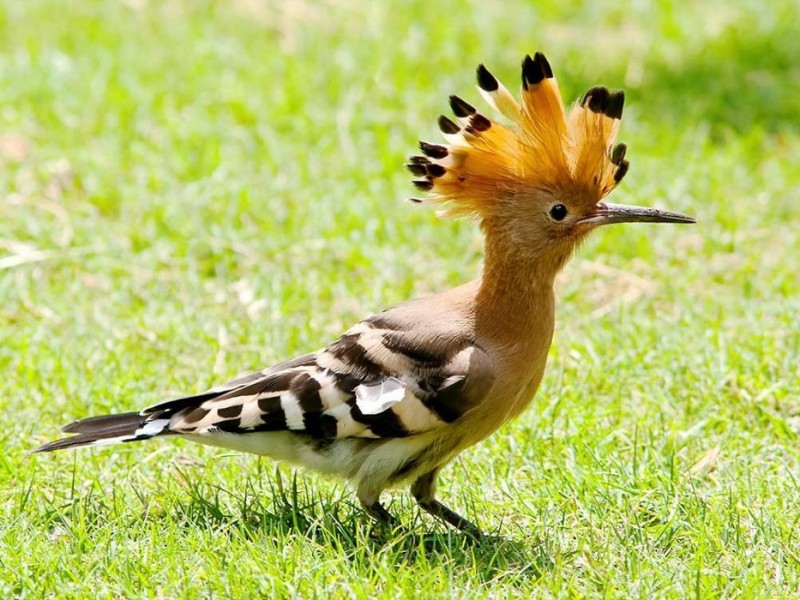
The hoopoe is one of the most beautiful inhabitants of central and southern Russia. However, it can be found in other countries as well. The hoopoe is found in most European and North African states.
The hoopoe cannot but attract attention. The bird is colored bright orange, almost cinnamon in color, and the wings are covered with contrasting white and black stripes. Therefore, the hoopoe attracts the eye both in flight and on the ground. In addition, on the bird's head there is a bright, orange crest with black and white edging.
Hoopoes are interesting not only for their bright, memorable and impressive appearance, but also for their unusual behavior. They actively use contrasting colors both during mating dances and to scare off opponents. When it is required to 'impress', the hoopoe fluffs the crest and spreads its wings like a tent.
Hoopoes love to settle in forests, forest plantations and groves. Despite the fact that the bird is rather shy, it is not difficult to find its nest. By smell. Hoopoes have a special coccygeal gland that secretes a pungent and smelly secret. Males mark territory with them and scare away predators.
Hoopoe can be found while walking. And if it doesn't work out, the bird easily takes root in captivity and is often found in zoos and poultry houses.
Maned pigeon
Rating: 3.9

The maned (aka Nicobar) pigeon is one of the most beautiful pigeons. This bird was discovered quite recently, while it is poorly studied, but not at all a hike on the usual city turtle doves. The body of the maned pigeon is covered with long, flexible iridescent feathers, whose color ranges from blue to red, from green to yellow.
Especially long feathers on the neck. Because of this, they resemble a mane or just hair. At the same time, they constantly shimmer with all colors and shades, which is why the pigeon seems to be something unreal.
Maned pigeons have been hiding from science for a long time, since, in principle, they lead an inconspicuous lifestyle. They are most often found in the jungle on uninhabited islands. Maned pigeons are mainly terrestrial, flying up trees only in case of danger.
Like other species of pigeons, maned pigeons can exist in captivity. However, they reproduce very slowly and poorly, and their catch for keeping in zoos and nurseries leads to a reduction in the natural population. Therefore, maned pigeons are protected by international organizations.
Attention! This rating is subjective and does not constitute an advertisement and does not serve as a purchase guide. Before buying, you need to consult with a specialist.









